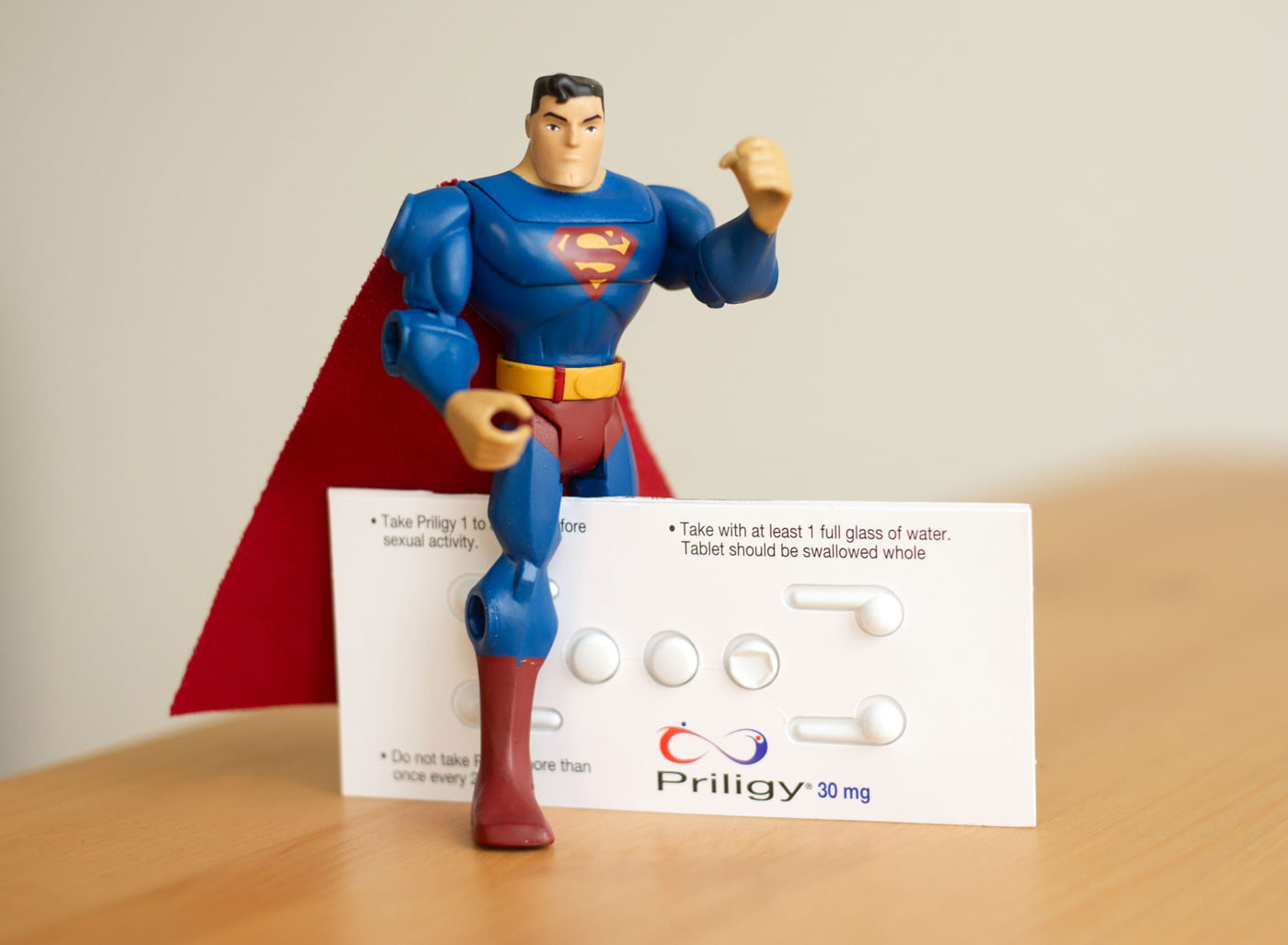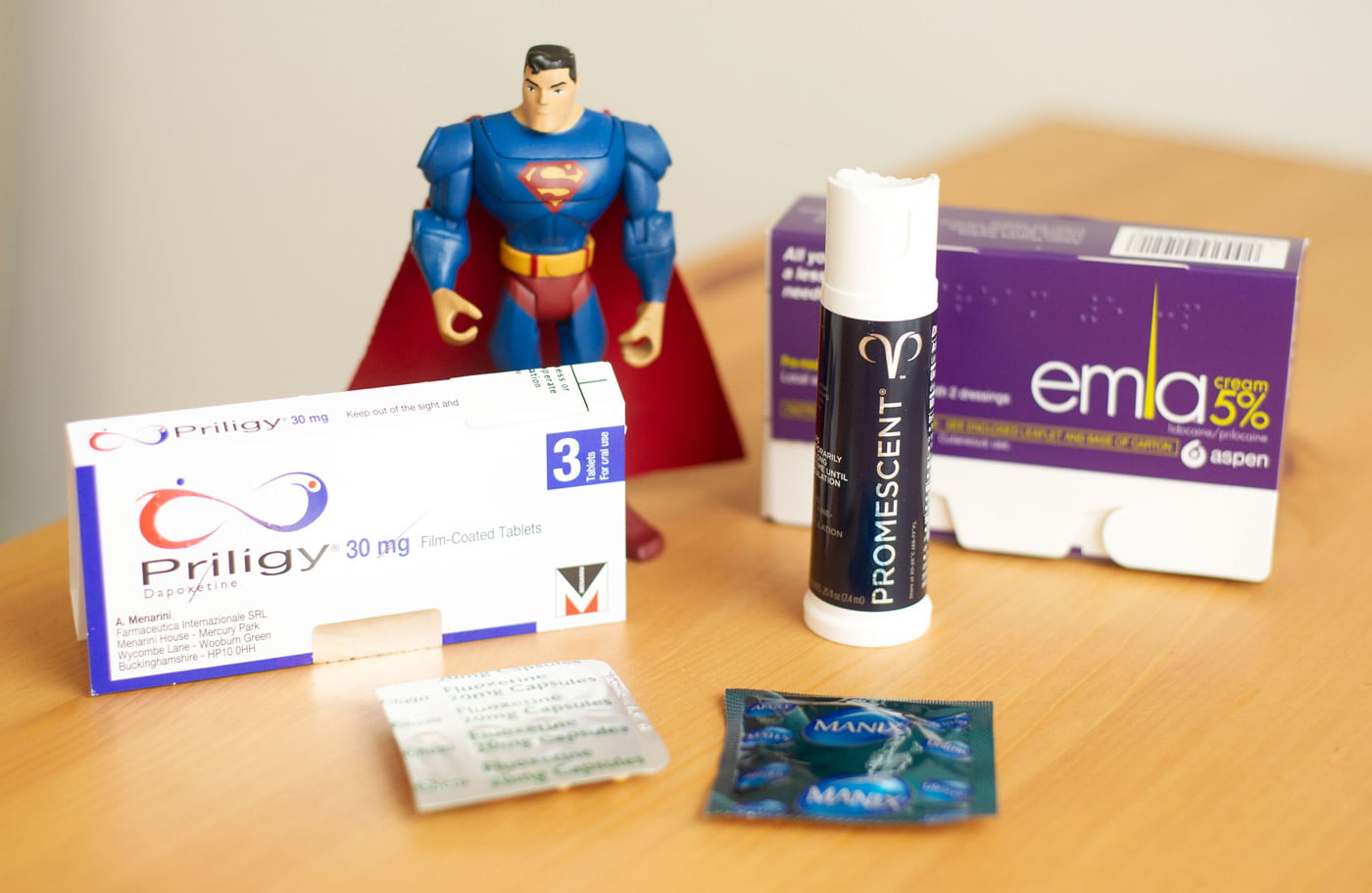Premature ejaculation is an extremely common concern for millions of men, so it’s no surprise that a treatment industry has developed around it. We’re talking creams, sprays, pills, books, self-help courses, therapies and scary surgeries. And just like any treatment industry, there’s no shortage of snake oil and nonsense in the mix.
So how to treat premature ejaculation? Ideally, an approach that tackles the causes, is free from side-effects and has real, lasting results.
Is this too much to ask? Can PE really be cured, naturally and permanently?
Medical treatments
To begin, here’s an excellent summary of the causes and underlying physiology of premature ejaculation. Urologist Dr Sriram Eleswarapu clearly explains the potential benefits of medication and psychotherapy as treatment options.
Numbing creams, sprays and condoms
These products contain a local anaesthetic such as prilocaine or lidocaine. They are applied directly to the penis to reduce sensitivity before having sex. ‘Climax delay’ condoms contain the same product and may also be slightly thicker to further reduce sensation.
Creams and sprays present some challenges: applying the correct amount of cream takes practice, and going to work with a numb penis also takes some getting used to. If any of the product rubs off, your partner will experience numbness too. This can be avoided by wearing a condom for as long as it takes the product to absorb, or washing the cream off before making physical contact.
Pills with a useful side-effect
Intended for the treatment of depression and anxiety, SSRI pills have a common side-effect: difficulty or delay in reaching orgasm. Sertraline, paroxetine, fluoxetine and other varieties are prescribed off-label for men who struggle to last longer in bed. They are taken daily and men usually notice some improvement within a couple of weeks.

Dapoxetine is an SSRI pill developed specifically for the treatment of premature ejaculation. Like Viagra, dapoxetine has the benefit of working on-demand rather than requiring a daily dosage. It is available in many countries under the Priligy brand.
The list of other side-effects is significant, including weight gain, nausea, diarrhoea and mood alteration. Studies show that a high proportion of men stop using SSRIs, typically citing disappointing results and side-effects.1
Can Viagra help with premature ejaculation?
Viagra is famously a treatment for erectile dysfunction, but it features here for two reasons. Firstly, premature ejaculation is sometimes a secondary issue from erectile dysfunction, so medication such as Viagra, Levitra or Cialis will play a role in treating the condition.
These medications can also shorten a man’s refractory period. This will increase his chances of reaching orgasm twice in a single session, and he may well last longer the second time. His sexual confidence will be improved too. Some men resort to using Viagra combined with SSRIs to cover all bases, but this is not generally recommended.
Penis surgery (ouch)
A drastic approach is selective resection of the dorsal nerve of the penis. This procedure blocks neural feedback from the penis and reduces sensitivity, but there is limited evidence of its effectiveness so far. According to the ISSM guidelines, such surgery is currently considered invasive, irreversible and unsafe. It is definitely not recommended.
Acupuncture
At least one clinical study has found acupuncture to be effective in delaying ejaculation. When men received twice-weekly acupuncture sessions, their intercourse duration times were doubled compared to men receiving a placebo treatment. In the same study, paroxetine SSRI pills proved to be more effective than acupuncture, but only by a matter of seconds.2
Psychological treatments
Systematic desensitisation for anxiety
For men who struggle with feelings of anxiety around their sexual performance, systematic desensitisation can be a useful treatment approach. They will learn a relaxation technique, and then compile a list of anxiety-inducing scenarios around the issue. One step at a time, they will learn to mentally rehearse each scenario while remaining calm and relaxed.

This employs the psychological principle that imagination and positive expectation can enhance real-world experience. When sex is approached in a less emotionally-aroused state, the sympathetic nervous system can be kept in check for longer.
Psychosexual counselling
This treatment can take many forms, but typically involves talking to a therapist about psychological issues that might be contributing to premature ejaculation. Issues of stress, guilt, resentment, skewed perceptions of sex and intimacy fears can all raise anxiety levels around sex. Development of awareness and emotional intelligence skills can also help shift our focus from ‘performance’ to ‘shared experience’.
Cognitive Behavioural Therapy
Another method for reducing anxiety levels around sexual performance is CBT. It works on the premise that our thoughts influence our emotions and behaviours. By learning to reframe their cognitive perception of intimacy, desire, shame and fear, the theory goes than men can approach sex with calmness and confidence. CBT is sometimes used in combination with sexological therapy methods such as sexual understanding, communication, sensate focus and foreplay techniques.
Physiological treatments
Kegels and pelvic floor exercises
Kegel exercises train the pubococcygeus muscles (‘PC muscles’) which support the pelvic organs. The PC muscle plays a major role in the erection and ejaculation processes, and the theory is that increased awareness and control will bring improvements to sexual function.
The basic exercise is easy and can be discreetly practised while sitting, standing or walking. For beginners, the PC muscle can be located by deliberately stopping urination mid-stream; the muscle contraction that you feel is your PC muscle at work. A typical kegel exercise routine involves contracting the muscle for three seconds and then relaxing, repeating for ten or twenty reps. There are many variations, including reverse kegels and exercises that attempt to target specific areas of the pelvic floor.

Most PE advice websites and books emphasise the importance of kegels, often giving men the impression that PC muscle control is the solution to lasting longer. It’s important to remember that at the point of ejaculation, the PC muscle contracts as a reflex response that is beyond our control. No amount of clenching or kegelling will override this natural process.
There are benefits to practising kegels, however, including increased mind-body awareness and learning how to relax the pelvic floor. This can certainly help to manage sexual excitement well before reaching the point of ejaculation. The Rising Master website has an excellent guide for aspiring kegel masters.
Electronic muscle management
A manufacturer called Virility Medical is taking an innovative approach to treatment with their skin patch invention. Neuromuscular stimulation is the name of the game. The single-use adhesive patch carries an electronic module, and is applied to the perineum just behind the testicles. When paired with a smartphone app, the developers claim that it will deliver stimulation to the adjacent nerves and muscles and delay the PC muscle contractions associated with ejaculation.
Initial test data looks positive, although the product appears to still be in early concept stage of development. One to watch for the future.
Sexological and behavioural treatments
This objective of this approach is to ‘fill in the gaps’ in a man’s sexual awareness and expertise. Through practical sex advice and exercises, he can identify any unhelpful habits that have been preventing him from fully relaxing and managing his sexual excitement.
Sexological therapy has two main objectives:
Objective one: Managing the quantity and intensity of received stimulation
Position and tempo
Sex positions make a big difference to a man’s ability to last, and variation and experimentation is key. Men who experience premature ejaculation tend to find a position (typically missionary position) that gives them some feeling of control and they stick to it. They avoid positions that limit their control (such as girl-on-top), even if their partner might enjoy these moves.
Treatment means learning the advantages of different positions and becoming more confident in trying them. Position affects muscular tension through the whole body, friction points and, crucially, the angle of pelvic thrusting. The tempo and rhythm of thrusting is a major factor too, and is something that men often misunderstand due to watching porn performers bang away.
Therapy involves reawakening an instinct of openness and experimentation, understanding that what works for one man doesn’t necessarily work for every man. If a recommended position (say spooning or side-by-side) doesn’t work for us, there are plenty of other positions that might.
Stop and start technique
Many men develop the habit of withdrawing during intercourse to take a break and calm things down. Sexological therapy helps men to understand how to use this technique to train and develop their ability to manage excitement, rather than rely on interruption as a permanent tactic. Effective as it might be in making sex last a little longer, the constant stop-start can be problematic for the partner. When the tactic is used, learning what to do during the pauses is also essential.
Objective two: Mastering the physiological response to sexual excitement
Remembering that rising sexual excitement brings us to orgasm, there are two parts of the acceleration process that we can consciously control: muscle tension and breathing. Sexological treatment means learning how to do this during sexual interaction. While this may sound obvious, understanding how these responses are easily hijacked by sexual arousal is an essential part of therapy.
Muscle relaxation and pelvic movement
Sexological treatment gets right down to the mechanics of pelvic thrusting, as many men don’t know how to do this without tensing the muscles of the lower body. Learning and rehearsing different ways of movement can make a huge difference to intercourse duration.
Breathing out the tensions
A key part of behavioural therapy is understanding how breathing affects tension and rising sexual excitement. Immersed in the stimulation of sex, men tend to become oblivious to their breathing patterns or pay superficial attention to it. As mentioned above, breathing technique is a proven way to delay the triggering of the sympathetic nervous system essential for ejaculation.
Focus technique
While breathing and relaxation might seem like easy processes for us to monitor and control, achieving this during sex is a skill to be mastered. This is because our field of consciousness shrinks as our sexual excitement builds. We lose contact with the external world and a large part of our inner awareness. As we approach orgasm, our focus narrows further and all the performance tips and advice we try to utilise become ineffectual.
Behavioural therapy can teach us how to mentally step back from this natural, narrow focus without retreating from the sexual experience. We can regain awareness of our surroundings, our partner, the sensations across our whole body and our rising levels of sexual excitement. Rather than trying to distract ourselves with forced thoughts of football or work emails, we learn a new way of focusing on the sensations of sex.
Additional sexological methods
The Squeeze technique
This technique was developed for couples who desired longer-lasting sexual intercourse. The man is encouraged to withdraw when he feels close to orgasm, and his partner is instructed to place her hand around the head of his penis (near where the head joins the shaft) and apply gentle pressure until his erection softens a little and the urge to ejaculate passes. When his arousal is sufficiently reduced, the couple can resume intercourse.

Renowned sex therapists Masters and Johnson developed the squeeze technique in 1970, recommending that couples adhere to this approach for 6 to 12 months. Studies have recorded some success over the years, although it has been noted that the benefits may not be long lasting.
Sensation perception technique
This is another behavioural technique developed for couples which places emphasis on non-intercourse stimulation of his penis. He is encouraged to focus on his sensations and arousal levels, relieved of the pressures of intercourse and satisfying his partner. When he feels close to orgasm, stimulation is paused until he is sufficiently relaxed. After a number of these sessions, he is able to experience more awareness and control.
Despite recorded improvements, the main drawback to such techniques is that they aren’t particularly sexy. The couple have discussed and committed to adopting the technique together, but the benefits might not continue after they have resumed normal intercourse again.
Masturbation to the edge
Of course, this self-help treatment is available to us all. Edging is start-stop masturbation, where we bring ourselves close to orgasm, pause until we are sufficiently relaxed and then resume. We might repeat this multiple times until we are able to last for a desired length of time. There are many edging plans available online, often including detailed schedules and timings designed to gradually increase duration. As we progress, we can incorporate visualisation, porn, fleshlights and lubes in order to simulate a more sexually charged experience.
Edging and masturbation training can certainly assist in overcoming premature ejaculation. It enables us to get more in touch with our bodily sensations and gain awareness of our own sexual excitement zones. We can experiment with different strokes and timings, and incorporate some of the breathing and muscle relaxation techniques discussed above.
The benefits of edging still need to be brought into the realm of sexual intercourse, and that can be quite a challenge. Remember that the majority of men last significantly longer when masturbating compared to having sex with a partner.
So what is the best treatment for premature ejaculation?
With all of the treatment options available, from self-training to therapy sessions to medication, it is perfectly possible for the vast majority of men to enjoy intercourse for longer. But which approach actually works?
When reviewing the research on long-term effectiveness of different treatments, it’s essential to remember:
- There are no quick fixes for premature ejaculation. If a treatment or product promises instant results, we should question its credibility (and cost).
- Every man who struggles with premature ejaculation experiences it differently. We are all unique in terms of our life experience, sexual desires, physiology and perceptions of sex.
- In the vast majority of cases, there are multiple contributing factors. The more we experience the problem in our lives, the more we accumulate stress around it. If we become less resourceful and more fixed in our thinking, avoidance and hopelessness sets in. Trying to unpick the problem with a single intervention is likely to fail.
This is the problem with many treatment plans, books and products. They offer a singular fix to a multidimensional problem. The ’30-Day Edging Plan’ is not going to address a man’s fear of intimacy, especially in the long-term. ‘Stallion 5000 Cream’ is not going to develop his self-confidence around women. Psychotherapy will help with feelings of shame and self-worth, but it won’t teach a man how to move his pelvis in a way that minimises muscular tension.
That’s not to say that these treatments aren’t helpful. Try them by all means, but I advocate a more holistic approach.
Research and experience proves that combining treatments, tailored to our own unique requirements, is the most successful strategy for the long-term. The most effective approach is one that addresses psychological and behavioural hangups, and we will explore this further in this section.
The problem with pills
The modern-day approach to healthcare is fixated on medication. We go to the doctor, have a ten minute discussion about our problem and all the anxieties around it and walk out with a prescription. Take this pill every day and see how you get on. Medication is convenient and vastly cheaper than sessions with a sex therapist or counsellor.
We certainly see this trend in the treatment of premature ejaculation with SSRI medication, especially since fast-acting dapoxetine came along. Even if your doctor won’t prescribe them or dapoxetine isn’t licensed in your country, this medication is easily available after a bit of Googling.

Don’t get me wrong – SSRI pills can certainly help, but they are best used in tandem with another treatment or approach. Sometimes, they can buy us precious time to maintain our relationships while we understand and seek help for the actual causes of the issue. Depending on pills alone is missing an opportunity to truly develop our sexuality and relationships.
Researchers agree that by combining medical and psychological treatments, we may be able to rapidly address the symptoms of PE while addressing the psychological and interpersonal issues that either caused or prolonged the problem in the first place.3
Experts have pointed out that simply teaching men to approach sex with a more open and experimental mindset is preferable to medication alone. A 2017 Journal of Medical Ethics report concluded that “extension of the sexual repertoire and liberation from the coital imperative have the potential to improve the sexual lives of many more than those who experience relief from SSRI- enhanced IELTs.”4
The ISSM guidelines confirm that in all studies so far, combination therapy is superior to medication alone. SSRI pills on their own are not sufficient to address performance anxiety, self-confidence issues, relationship and sexual factors or life stressors.
The success of combined treatments
A major step forward in treating premature ejaculation is Functional Sex Therapy. This takes a holistic approach towards managing sexual excitement, incorporating psychological education, body awareness, breathing and functional movement exercises. Men typically follow a practical 12-week training course, either working with a therapist or reading and practising the exercises on their own.
Although this approach is relatively new, a 2006 study evaluated its effectiveness compared to SSRI medication. After following the Functional Sex Therapy programme, the participants’ average duration of intercourse increased from 42 seconds to almost 8 minutes. By comparison, participants given an SSRI prescription experienced a time increase to almost 5 minutes. So men following the functional therapy programme experienced significantly better results, avoiding the side-effects of medication and gaining lifelong sexual skills.5
Remember that on average, women take around 8 minutes to reach orgasm through intercourse. Without setting targets too specifically, we can see how the combined approach to treatment helps to synchronise male and female sexual excitement levels.
Sexual Enhancement Therapy
All forms of personal development training require us to take learned skills into our real experience. When it comes to sex therapy, there is a world of difference between the learning environment and the flood of stimulation that is sexual intercourse. As practical as functional therapy is, men can still find it extremely difficult to apply the techniques when having sex with their partners. They feel a huge disconnect between mind and body and it’s easy to fall back into hopelessness.
The main reason for this block is emotional arousal. When we are training on our own, it’s much easier to access the state of relaxation and awareness that makes all the difference. To use a sports performance term, we are in mental flow. When we try to access this flow during sex, we’re in a state of emotional arousal and everything feels different. Once again, we’re in the grip of performance anxiety.
Sexual Enhancement Therapy is my developed approach to addressing this fundamental block. It draws upon the sexological and behavioural insights from functional therapy, combined with proven techniques for emotional regulation and deep relaxation. There are strategies to specifically overcome sexual performance anxiety and keep the sympathetic nervous system in check. These techniques draw upon the essential insights of the Human Givens model of therapy.
Sexual Enhancement Therapy has the following aims:
- Broaden our understanding of sexual excitement: the things we can and cannot control.
- Address our emotional arousal around sex. This is essential for reliable relaxation and access to our resources during sex, otherwise we just revert to our old ways.
- Address our unhelpful and often long-standing habits of sexual expectation, position, movement and stimulation. In other words, learn how to effectively manage our sexual excitement and overcome premature ejaculation.
Education and myth-busting
Providing information about the realities of PE goes a long way, clearing up any embarrassing myths and misinformation. It’s essential to understand just how common a concern this is, and why we might have been stuck in a loop of frustration and avoidance.
Sexual Enhancement Therapy provides a clear explanation of sexual excitement and the natural ejaculation response. It encourages us to reconnect with our innate, positive curiosity and fascination for sex. It sets up a positive expectation for change. When we relieve ourselves of the pressure and expectation to ‘deliver the orgasms’ and we become more aware of interpersonal and relationship factors, we’re on the path to satisfying sex.6
Lowering emotional arousal
We’ve already touched on the practical benefits of abdominal breathing and muscle relaxation for effectively prolonging intercourse. These are key skills in the functional therapy programme. Sexual Enhancement Therapy takes this further, introducing a ‘state-switching’ technique to prevent performance anxiety from hijacking our management of sexual excitement.
By adopting these techniques during rehearsal of functional skills, the beneficial effects are twofold. Firstly, we are able to fully immerse ourselves in our new sexual perspective. New learnings can properly sink in. Then when we are enjoying sex with a partner, we are able to access this relaxed and confident state.
Managing sexual excitement
This is where Sexual Enhancement Therapy gets into the mechanics of sexual technique. As mentioned previously, functional training has two key objectives:
- Managing the quantity and intensity of received stimulation.
- Mastering the physiological response to sexual excitement.
This is achieved through the correction of ‘bad form’ and the rehearsal of sexual movement. Positions, angles, tempo are all addressed, whilst learning how to be more aware of stimulation and excitement levels. Techniques of sexual mindfulness are also introduced, to avoid the narrowing of consciousness and to mentally ‘step back’ when excitement ramps up.
In summary, Sexual Enhancement Therapy is a holistic treatment for the multidimensional problem of premature ejaculation. By no means a quick fix, it can be followed over a period of 8-12 weeks in practical, accessible steps. It can be followed while taking medication and is effective as a stand-alone treatment. The proven benefits extend beyond the ability to last longer in bed. Our self-perception, sexual communication, intimate relationships and life experience are all enhanced by the process.
Can I adopt this approach myself?
Sexual Enhancement Therapy works well as a self-help treatment. It does require motivation, sufficient time and effort to follow the training plan. As a holistic approach, there are no short-cuts or hacks.
I will be publishing more information about this treatment on this site, including self-help articles and a full, interactive training course. In the meantime, if you would like to learn more about Sexual Enhancement Therapy or any of the elements discussed above, please do get in touch.

Footnotes for this article
- Jern et al. Antidepressant Treatment Of Premature Ejaculation: Discontinuation Rates and Prevalence of Side Effects Fordapoxetine And Paroxetine in a Naturalistic Setting. International Journal of Impotence Research (2014) 27, 75 –80
- Sunay D, Sunay M, Aydogmus Y, et al. Acupuncture versus paroxetine for the treatment of premature ejaculation: a randomized, placebo-controlled clinical trial. Eur Urol . 2011;59: 765-71
- Rowland D, Mc Mahon C, Abdo C, et al. Disorders of orgasm and ejaculation in men. Journal of Sexual Medicine. 2010;7: 1668-86
- Söderfeldt et al. Distress, disease, desire: perspectives on the medicalisation of premature ejaculation. Journal of Medical Ethics Published Online First: 23 March 2017. doi: 10.1136/medethics-2015-103248
- de Carufel F, Trudel G. Effects of a new functional-sexological treatment for premature ejaculation. J Sex Marital Ther. 2006 Mar-Apr;32(2):97-114
- Althof S. Treatment of Rapid Ejaculation: Psychotherapy, Pharmacotherapy, and Combined Therapy. In: Leiblum S, ed. Principles and Practice of Sex Therapy (4th Edition) . New York: Guilford Press; 2007


Leave a Reply